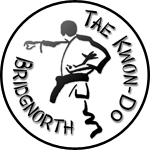Tae Kwon-Do is a Korean martial art inaugurated in Seoul in 1955 by General Choi Hong Hi, and introduced to the UK by Master Rhee Ki Ha in 1967.
-
Tae means to kick or smash with the foot
-
Kwon means to punch or destroy with the fist
-
Do means art or way of life.
No two classes at Bridgnorth Tae Kwon-Do will be exactly the same. The Tae Kwon-Do syllabus we follow allows for lessons to be varied and interesting, as there are various aspects of the martial art to cover:
Discipline
Discipline is embedded in Tae Kwon-Do. To succeed a student must be eager to learn and willing to achieve the five tenets of Tae Kwon-Do:
-
Courtesy (The instructor is called Sir or Ma’am as a sign of respect)
-
Integrity
-
Perseverance
-
Self-control
-
Indomitable spirit
Tae Kwon-Do is not designed to be easy, and of course students will get as much out of the lessons as they put in. The lessons are physically challenging and students must always treat the instructor and other students with respect. This makes Bridgnorth Tae Kwon-Do the ideal training venue for those students looking for a good work out and equally for junior students to learn important life skills.
Patterns
A pattern is a set of movements representing either attack or defence techniques. By completing a pattern the student deals with an imaginary opponent using the body as an attacking or blocking tool.
Each pattern has a different meaning and a special significance to Korea or Tae Kwon-Do.
Patterns are an intrinsic part of Tae Kwon-Do, because they allow the student to:
-
Develop sparring and self-defence techniques
-
Improve flexibility and fitness, as well as breathing control
-
Develop fluidity and smoothness in their motions
-
Develop power without a real-life opponent.
A beginner at Tae Kwon-Do will wear a white belt and will learn one pattern per grading in order to achieve their next belts. The gradings test the student’s ability to perform patterns well, with precision and with power. There are nine patterns to learn between white belt and black belt.
Sparring
Sparring teaches the Tae Kwon-Do student important skills:
- Distance from the opponent
- Importance of direction of facing
- Correct blocks and stances
- Timing
- Practicing and refining both attack and defence techniques, against a real opponent.
At Bridgnorth Tae Kwon-Do we follow a syllabus of the following:
- Three-step sparring (Sambo Matsoki)
- Two-step sparring (Ibo Matsoki)
- One-step sparring (Ilbo Matsoki)
- One for one sparring
- Semi-free sparring (Ban-jayoo Matsoki)
- Free sparring (Jayoo Matsoki)
Each of these types of sparring serves a different purpose for the student. The progression from three-step sparring on to free sparring allows the student to become more confident with an increasing ability to judge distance from their opponent. The sparring techniques listed above start in a very structured approach, with three-step and two-step sparring following a prescribed set of movements for both attacker and defender. As these skills develop and the student moves onto one-step sparring and beyond, the student is increasingly able to be creative in their attacking and defensive techniques. Self defence is a crucial aspect of Tae Kwon-Do and the student must always be able to demonstrate an equal ability to defend as well as attack, during sparring activities.
Self Defence
At Bridgnorth Tae Kwon-Do we teach a useful and practical self-defence syllabus. This includes:
- Releases from grabs, either around the wrist or the collar, where the attacker uses one or both hands
- Releases from bear-hugs and front or side head-locks
- Attacks from behind or over the shoulder
- Restraining a friend who has had one too many pints and become aggressive – using control but without causing injury
- Self defence against weapon attacks.
Power Test
Tae Kwon-Do students who perform the martial art correctly should be developing power, even when they are not working with a real-life opponent. Students will have the opportunity to test their power and precision of technique during lessons and at gradings, against punch bags for junior students and boards for senior students.
Theory
Tae Kwon-Do is not just an exercise for the body but also for the mind. Students will learn Korean history and language, taking instructions in a mixture of Korean and English. Don’t worry, you won’t be expected to ask for directions to the nearest train station in Korean, but students will be introduced to the Korean language from their very first lesson. Students are expected to revise Korean terminology for their gradings, and will be tested on knowledge of translations of key instructions and terminology.
Students can download theory sheets for each colour belt grading and we also recommend the GTI Handbook which contains full theory and lots of useful information to help you on your Tae Kwon-Do journey.
This Curriculum page has been designed to give a potential student a fair overview of what to expect from lessons. It will take around 4 years to achieve a black belt in Tae Kwon-Do, so this isn’t all learnt overnight! Most of all, Tae Kwon-Do is a challenging and massively rewarding sport to take part in. Students are offered a completely free, no-obligation trial for four lessons. If you are interested in joining us, please contact us or pop in to observe any lesson – you will be more than welcome.
Gradings
Colour belt gradings take place every three months, either at Bridgnorth Leisure Centre, Highley Severn Centre or Much Wenlock Leisure Centre. Eligibility to grade is based on effort, attitude and ability only – if you’re ready we will never hold you back, but if you’re not ready, you’re not. Black Belt gradings are held at Master Tony Sewell’s academy in Derby, in Spring and Autumn.
